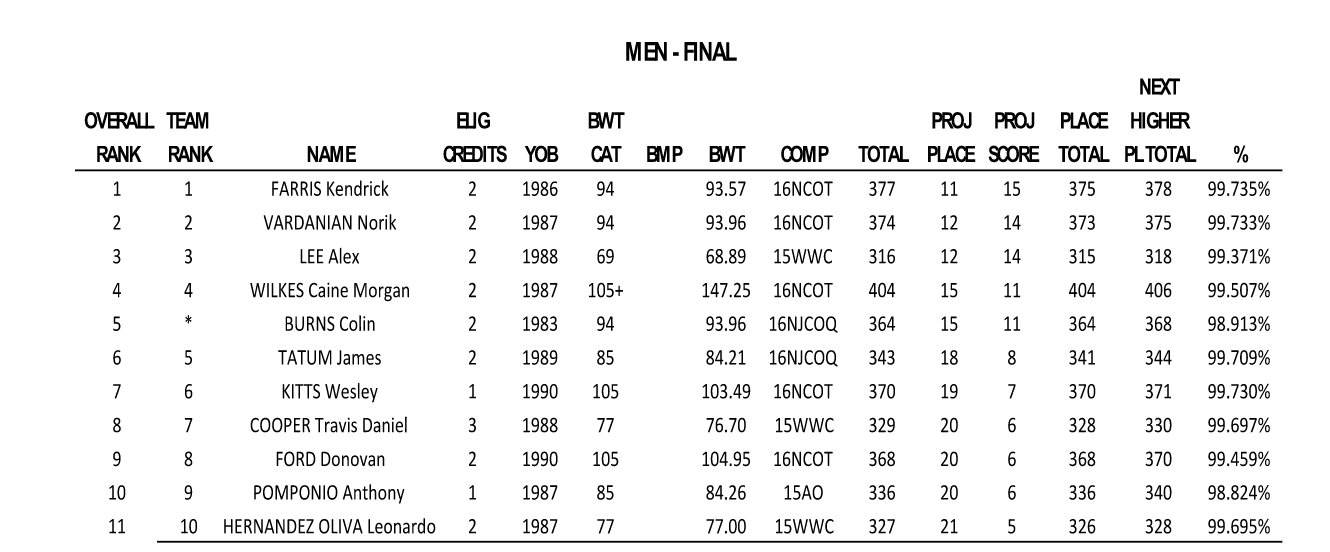Pan American Senior ChampionshipsJun 4, 2016 by FloElite Staff
Predicting The US Men's Olympian Part 1
Predicting The US Men's Olympian Part 1
As we approach the Pan-American Championships, one question comes to mind: “Which male athlete will represent the United States at the 2016 Olympics?” Befor

As we approach the Pan-American Championships, one question comes to mind: “Which male athlete will represent the United States at the 2016 Olympics?”
Before we begin to speculate, we first need to understand the ranking system. This article will review our country’s top male athletes and assess their potential to secure a spot on this year’s U.S. Olympic Team.
Due to a subpar performance at the 2015 World Championships, the U.S. was unable to secure any Olympic spots for the men’s team. As a result, Pan-Ams is of the utmost importance. For the U.S. to earn one spot, they need to place at least seventh. Historically competitive teams Mexico and Ecuador are no longer in the running, so a seventh-place finish at the least looks promising. There are no guarantees, but if all of the U.S. men post a total at Pan-Ams, they will likely secure the Olympic spot.

With two athletes (at most) from each weight class, our Pan-Ams team is composed of the top eight lifters (nine and 10 being alternates). While this ranking was updated immediately following the Trials, it is not an indicator of who will be the next male Olympian for the U.S. For the men’s team, the Trials determined who would be eligible for Pan-Ams. Our highest male finisher at Pan-Ams will be the 2016 U.S. Olympian.
Following the 2016 National Championships and Olympic Trials, a ranking list came out that showed the athletes eligible to compete at Pan-Ams. This list was populated using the National Classification System (NCS) Matrix. The NCS Matrix is composed of the 2014 and 2015 Olympic Games Qualification Events, and averages the bronze medalist’s total in each weight category:

The ranking is based on each lifter’s ability to score points for the U.S. As shown above, each weight category has a total that corresponds to a “Place” in competition, as well as the number of “Points Earned” based on that placement.
Confusing? Slightly.
Let’s look at the highest-ranked lifter from the Trials as an example:

Kendrick Farris is a 94kg lifter. At the Trials, he totaled 377kg. Checking the 94kg section of the NCS Matrix, we can see the closest total to his (less than or equal to) is 375kg, which would award him 15 points for 11th place. The next-closest total, which would award a higher place, is 378kg.
Now, take into consideration Kendrick’s total; the number of points he earned; and how close he is to moving up one place (by percentage). That’s how the men’s ranking was populated for the Pan-Ams team.
Each athlete competing at Pan-Ams has a shot at the one Olympic spot. Who will it be?
Stay tuned for the second part of this article, which will outline our prognostications.
By Jake Baker
Before we begin to speculate, we first need to understand the ranking system. This article will review our country’s top male athletes and assess their potential to secure a spot on this year’s U.S. Olympic Team.
Securing Our Only Olympic Spot
Due to a subpar performance at the 2015 World Championships, the U.S. was unable to secure any Olympic spots for the men’s team. As a result, Pan-Ams is of the utmost importance. For the U.S. to earn one spot, they need to place at least seventh. Historically competitive teams Mexico and Ecuador are no longer in the running, so a seventh-place finish at the least looks promising. There are no guarantees, but if all of the U.S. men post a total at Pan-Ams, they will likely secure the Olympic spot.
Our Top-Ranking Male Athletes

With two athletes (at most) from each weight class, our Pan-Ams team is composed of the top eight lifters (nine and 10 being alternates). While this ranking was updated immediately following the Trials, it is not an indicator of who will be the next male Olympian for the U.S. For the men’s team, the Trials determined who would be eligible for Pan-Ams. Our highest male finisher at Pan-Ams will be the 2016 U.S. Olympian.
How The Ranking List For Pan-Ams is Created
Following the 2016 National Championships and Olympic Trials, a ranking list came out that showed the athletes eligible to compete at Pan-Ams. This list was populated using the National Classification System (NCS) Matrix. The NCS Matrix is composed of the 2014 and 2015 Olympic Games Qualification Events, and averages the bronze medalist’s total in each weight category:

The ranking is based on each lifter’s ability to score points for the U.S. As shown above, each weight category has a total that corresponds to a “Place” in competition, as well as the number of “Points Earned” based on that placement.
Confusing? Slightly.
Let’s look at the highest-ranked lifter from the Trials as an example:

Kendrick Farris is a 94kg lifter. At the Trials, he totaled 377kg. Checking the 94kg section of the NCS Matrix, we can see the closest total to his (less than or equal to) is 375kg, which would award him 15 points for 11th place. The next-closest total, which would award a higher place, is 378kg.
Now, take into consideration Kendrick’s total; the number of points he earned; and how close he is to moving up one place (by percentage). That’s how the men’s ranking was populated for the Pan-Ams team.
Each athlete competing at Pan-Ams has a shot at the one Olympic spot. Who will it be?
Stay tuned for the second part of this article, which will outline our prognostications.
By Jake Baker